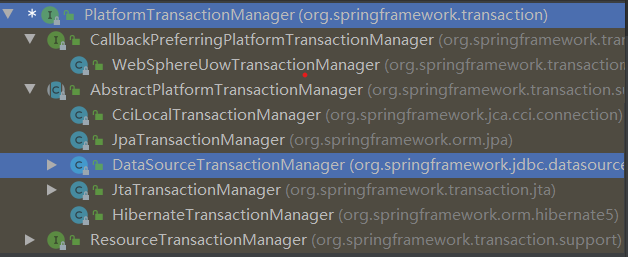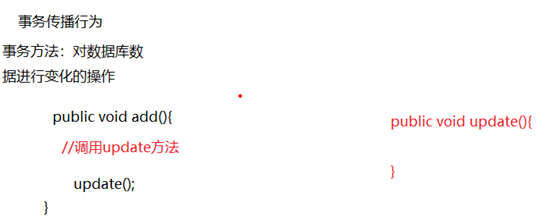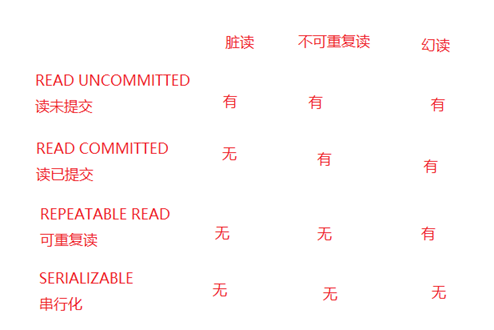Spring -事务操作
1、事务概念
a)事务是数据库操作的最基本单元,逻辑上一组操作,要么成功,如果有一个失败所有都失败。
2、事务特性(ACID)
a)原子性
b)一致性
c)隔离性
d)持久性
3、搭建事务操作环境
a)创建数据库表,添加记录
b)创建service,搭建dao,完成对象创建和注入
(1)service注入dao,在dao中注入jdbcTemplate,jdbcTmplate中注入dateSource
@Service public class UserService { @Autowired private UserDao userDao; //转账 public void accontMoney(){ //多钱 userDao.addMoney(); //少钱 userDao.raduceMoney(); } } public interface UserDao { public void addMoney(); public void raduceMoney(); } @Repository public class UserDaoImpl implements UserDao { @Autowired private JdbcTemplate jdbcTemplate; //多钱 @Override public void addMoney() { String sql="update t_account set money=money+? where name=?"; jdbcTemplate.update(sql,100,"jack"); } //少钱 @Override public void raduceMoney() { String sql="update t_account set money=money-? where name=?"; jdbcTemplate.update(sql,100,"rose"); } }
(2)xml 配置
<beans xmlns="http://www.springframework.org/schema/beans" xmlns:xsi="http://www.w3.org/2001/XMLSchema-instance" xmlns:context="http://www.springframework.org/schema/context" xmlns:aop="http://www.springframework.org/schema/aop" xsi:schemaLocation="http://www.springframework.org/schema/beans http://www.springframework.org/schema/beans/spring-beans.xsd http://www.springframework.org/schema/context https://www.springframework.org/schema/context/spring-context.xsd http://www.springframework.org/schema/aop https://www.springframework.org/schema/aop/spring-aop.xsd"> <bean id="dataSource" class="com.alibaba.druid.pool.DruidDataSource" destroy-method="close"> <property name="url" value="jdbc:mysql:///xz520?serverTimezone=UTC" /> <property name="username" value="root" /> <property name="password" value="root" /> <property name="driverClassName" value="com.mysql.jdbc.Driver" /> </bean> <!--配置jdbcTmplate对象--> <bean id="jdbcTemplate" class="org.springframework.jdbc.core.JdbcTemplate"> <!--注入dataSource--> <property name="dataSource" ref="dataSource"></property> </bean> <!--注解驱动--> <context:component-scan base-package="com.spring"></context:component-scan> </beans>
(3)测试
public class SpringTest { @Test public void TestAdd(){ ApplicationContext context=new ClassPathXmlApplicationContext("bean1.xml"); UserService user=context.getBean("userService", UserService.class); user.accontMoney(); } }
4、事务操作
a)事务添加到JavaEE三层的service层(业务逻辑层)
b)在Spring进行事务管理操作
(1)有两种方式:编程式事务管理和声明式事务管理(推荐使用)
c) 声明式事务管理
(1)基于注解方式(使用)
(2)基于xml配置文件方式
d) 在Spring进行声明式事务管理,底层使用AOP原理
e) Spring事务管理API
(1) 提供一个接口,代表事务管理器,这个接口针对不同的框架提供不同的实现类

注解声明事务管理
a) 在Spring配置文件配置事务管理器
<!--创建事务管理器--> <bean id="dataSourceTransactionManager" class="org.springframework.jdbc.datasource.DataSourceTransactionManager"> <!--注入数据源--> <property name="dataSource" ref="dataSource"></property> </bean>
b)在Spring配置文件,开启事务注解
(1)在Spring配置文件中引入名称空间tx
<beans xmlns="http://www.springframework.org/schema/beans" xmlns:xsi="http://www.w3.org/2001/XMLSchema-instance" xmlns:context="http://www.springframework.org/schema/context" xmlns:aop="http://www.springframework.org/schema/aop" xmlns:tx="http://www.springframework.org/schema/tx" xsi:schemaLocation="http://www.springframework.org/schema/beans http://www.springframework.org/schema/beans/spring-beans.xsd http://www.springframework.org/schema/context https://www.springframework.org/schema/context/spring-context.xsd http://www.springframework.org/schema/aop https://www.springframework.org/schema/aop/spring-aop.xsd http://www.springframework.org/schema/tx http://www.springframework.org/schema/tx/spring-tx.xsd">
(2)开始事务注解
<!--开启事务注解--> <tx:annotation-driven transaction-manager="dataSourceTransactionManager"></tx:annotation-driven>
(3)在service类上添加注解(或者在service类的方法上添加注解)
@Transactional ,这个注解可以加在类上,也可以加在方法上
把注解加载类上,这个类里面的所有方法都添加了事务
把注解加在方式上,只为这个方法添加了事务
@Service @Transactional public class UserService { @Autowired private UserDao userDao; //转账 public void accontMoney(){ //多钱 userDao.addMoney(); //模拟异常 int i=10/0; //少钱 userDao.raduceMoney(); } }
在service类上添加注释@Transactionl,注解配置的事务相关参数
1、Propagation:事务传播行为
多事务方法直接进行调用,在这个过程中事务是如何进行管理的

Spring 框架事务传播行为有7种
REQUIRED: 如果add方法本身有事务,调用update方法之后,update使用当前的add方法的事务(默认)
如果add方法本身没有事务,调用upadte方法之后,创建新的事务
REQUIRED_NEW: 使用add方法调用update方法,如果add无论是否有事务,都会创建新的事务,将已有的事务挂起
SUPPORTS: 如果有事务在运行,当前的方法就在这个事务内运行,否则它可以不运行在事务中
NOT_SUPPORTE: 当前的方法不应该运行在事务中,如果有运行的事务,将它挂起
MANDATORY :当前的方法必须运行在事务内部,如果没有运行的事务,就抛出异常
NEVER: 当前的方法必须不应该运行在事务中,如果有运行的事务,就抛出异常
NESTED: 如果有事务在运行,当前的方法就应该在这个事务的嵌套事务内运行,否则,就启动一个新的事务,并在它自己的事务内运行
2、isolation:事务隔离级别
(1) 事务有特性成为隔离性,多事务操作之间不会产生影响,不考虑隔离性产生很多问题
(2) 有三个读的问题:脏读、不可重复读、虚(幻)读
(3) 脏读:一个未提交事务被另一个未提交事务的数据
(4) 不可重复读:一个未提交事务读取到另一个已提交事务修改数据
(5) 虚读:一个未提交事务读取到另一个提交事务添加数据
解决:通过设置事务隔离级别,解决读问题

3、timeout:超时时间:事务需要在一定的时间进行提交,以秒为单位 默认值为:-1
4、readOnly:是否只读:true 只可查询 false 可以查询也可以增删改
5、rollbackFor:回滚 :设置出现哪些异常进行回滚
6、noRollbackFor:不回滚:设置哪些异常不进行回滚
XML声明式事务管理操作
1、在Spring配置文件中进行配置
a) 配置事务管理器
b) 配置通知
c) 配置切入点和切面
<!--1、创建事务管理器--> 主要id中的名称固定为:transactionManager <bean id="transactionManager" class="org.springframework.jdbc.datasource.DataSourceTransactionManager"> <!--注入数据源--> <property name="dataSource" ref="dataSource"></property> </bean> <!--2、配置通知--> <tx:advice id="tx"> <!--配置事务参数--> <tx:attributes> <tx:method name="accontMoney" propagation="REQUIRED"/> <!-- <tx:method name="accont*" propagation="REQUIRED"/>--> </tx:attributes> </tx:advice> <!--3、配置切入点和切面--> <aop:config> <!--配置切入点--> <aop:pointcut id="pt" expression="execution(* com.spring.service.UserService.*(..))"/> <!--配置切面--> <aop:advisor advice-ref="tx" pointcut-ref="pt"/> </aop:config>
完全注解开发式事务管理操作
1、创建一个配置类
@Configuration //配置类直接 @ComponentScan(basePackages = "com.spring") //注解扫描 @EnableTransactionManagement //事务注解 public class TxConfig { //配置数据库数据源 @Bean public DruidDataSource getDruidDataSource(){ DruidDataSource dataSource=new DruidDataSource(); dataSource.setDriverClassName("com.mysql.jdbc.Driver"); dataSource.setUrl("jdbc:mysql:///xz520?serverTimezone=UTC"); dataSource.setUsername("root"); dataSource.setPassword("root"); return dataSource; } //配置事务管理器 @Bean public DataSourceTransactionManager getDataSourceTransactionManager(DruidDataSource dataSource){ DataSourceTransactionManager dataSourceTransactionManager=new DataSourceTransactionManager(); dataSourceTransactionManager.setDataSource(dataSource); return dataSourceTransactionManager; } //配置JdbcTemplate对象 @Bean public JdbcTemplate getJdbcTemplate(DruidDataSource dataSource){ JdbcTemplate jdbcTemplate=new JdbcTemplate(); jdbcTemplate.setDataSource(dataSource); return jdbcTemplate; } }
测试类
@Test public void TestAdd2(){ ApplicationContext context=new AnnotationConfigApplicationContext(TxConfig.class); UserService user=context.getBean("userService", UserService.class); user.accontMoney(); }



 浙公网安备 33010602011771号
浙公网安备 33010602011771号